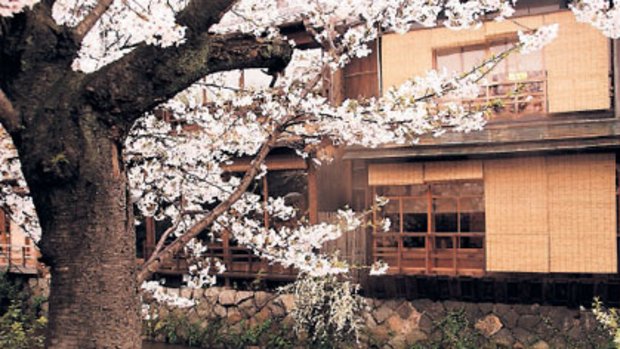
Cultural heart ...Kyoto’s wooden machiya houses are being restored.
When it comes to deciding where to stay in Japan, the choices are lopsided. If you want modern, the options are overwhelming. If you want traditional, there's just one style: a ryokan. These are family-run inns where guests bathe and eat together.
But in Kyoto – and only in Kyoto – there is a third way. Stay in a wooden machiya house and you can bask in old Japan without worrying about waking grandma upstairs.
These buildings once dominated the streets of Kyoto. Over the centuries many have been destroyed by fires and earthquakes and many were torn down during postwar reconstruction, as Japan remodelled itself in glass and concrete. Just as they seemed destined to be confined to history's architectural dustbin, they were saved.
The mastermind behind the restoration project is Alex Kerr, an American who came to Japan as a 12-year-old with his naval officer father in 1964. Since relocating in 1977, Kerr has devoted his life to the protection of Japan's architectural heritage. His company, Iori, has nine restored machiya on its books and more on the way.
The Izumiya-cho machiya, where I'm staying, is stunning. The front of the house has all the machiya trademarks: tiled roof, reed blinds and latticed windows. The frame of the building is raftered with giant antique beams, floors are laid with tatami mats and the walls on the ground floor are an earthen compound of clay and straw, with classic paper shoji screens pulled across the entrance to a balcony overlooking the river.
A traditional square cedar bath dominates the bathroom. After you've poured the water, earthy smells seep from the wood and it feels as if you are in a sauna in the middle of a forest. Alongside is a boutique hotel-style sink and washing area. The toilet has 13 buttons, various automated surprises and a computerised Japanese voice (which makes you feel a million miles from a sauna in the middle of a forest). The overall effect is spot-on: traditional Japanese surrounds, with such modern touches as a talking toilet. One of Japan's former capitals, Kyoto is the core of the Kansai region, the country's cultural and historical heart. Despite being only two hours from Tokyo by bullet train, the cityscape is nowhere near as intimidating, thanks to a municipal law that forbids buildings more than 12 storeys high. In the Gion region of the city, antiques fill shop windows, geisha wander the streets and, by night, lanterns are lit. The streets conform to a grid system but, with little English signage, it would be easy to get lost and confused. Thankfully, I have an annotated map supplied by Iori. I wander in Nishiki-Koji, a huge, covered food market. The trick, I'm told, is to look out for toothpicks – when one is plonked into a chunk of something, it is yours to sample. I taste four varieties of fried tofu in nine sauces, lumps of pickled plum and something that tastes like fish but is, in fact, a type of carrot. Kiyamachi, on the same street as my machiya, is the highlight. Its northern stretch is dotted with dance clubs, bars and restaurants but south of Shijo-dori, Kyoto's main artery, the atmosphere changes dramatically. The narrow road is flanked by a canal lined with cherry trees, whose smell competes with wafts of rosewater and tempura escaping from restaurants. Across the canal is a row of machiya, staggered in height and stretching into the distance. Kerr isn't the only person to have spotted the potential of the machiya. In the past 10 years, numerous businesses, particularly restaurants, have moved into the dwellings rather than follow the previous practice of buying them, razing them and rebuilding. The concierge directs me to one of them: Giro Giro Hitoshina (420-7 Nanbacho, Nishi Kiya-machi-dori). Its speciality is sosaku ryori, a creative reinvention of a traditional cuisine. Chefs work behind a square counter, lifting lids off steaming pots, dicing vegetables, whisking broths and joshing with the diners sitting on stools around them. They're working through the obligatory 10-course menu and getting drunk on sake and beer. The concierge's tip is appropriate. In the past, like the choice between the ryokan and Western hotels, eating in Japan was almost bipolar: either formal and traditional, or fast and Western. The restaurants found a middle ground a while ago. Now the holiday accommodation is catching up. Guardian News & Media Izumiya-cho, at Kiyamachi-dori, Bukkoji-sagaru, sleeps two to six people, with a double room from ¥40,000 ($535) a night. Iori has Kyoto machiya sleeping up to 14. See kyoto-machiya.com.
Sign up for the Traveller Deals newsletter
Get exclusive travel deals delivered straight to your inbox. Sign up now.